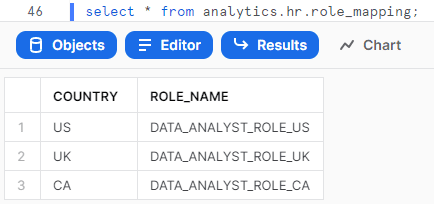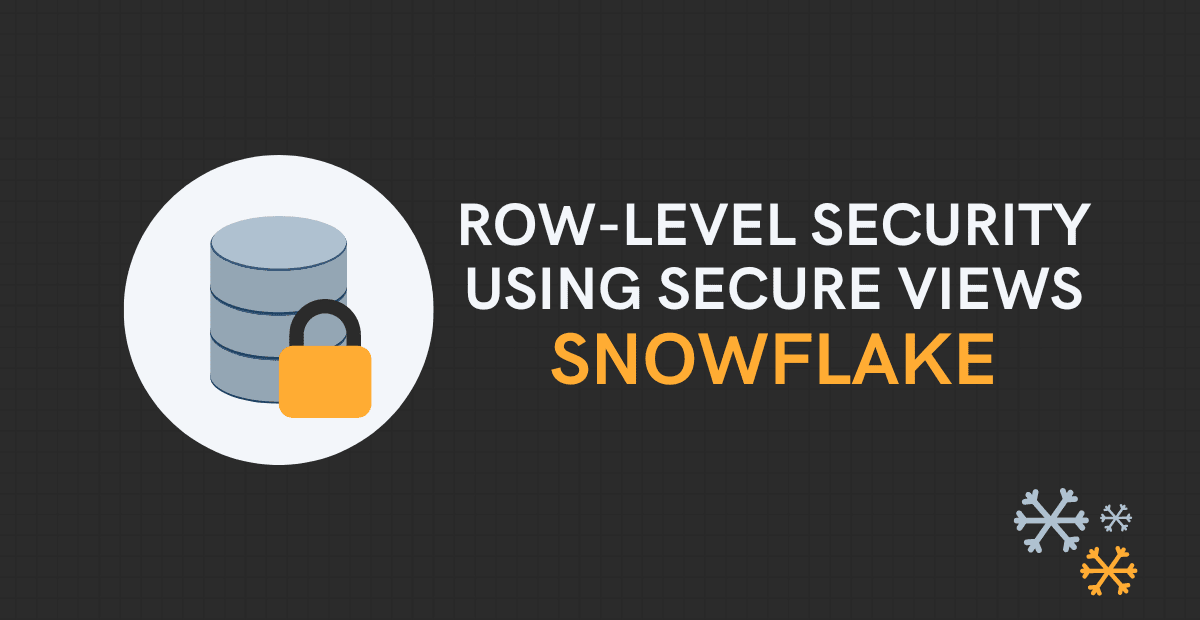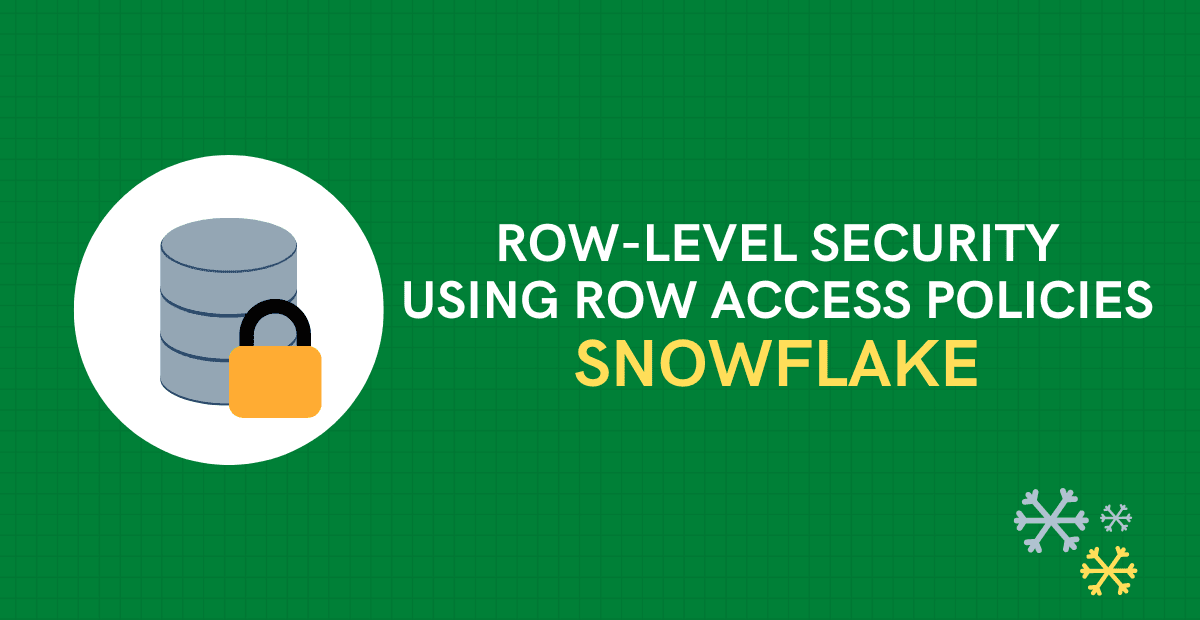1. What is Row-Level Security?
Row-Level Security is a security mechanism that limits the records returned from a database table based on the permissions provided to the currently logged-in user. Typically, this is done such that certain users can access only their data and are not permitted to view the data of other users.
In our previous article we have discussed how to implement Row-Level Security using Secure Views. In this article let us understand how to set up Row-Level Security on a database table using Row Access Policies in Snowflake.
2. What are Row Access Policies in Snowflake?
A Row Access Policy is a schema-level object that determines whether a given row in a table or view can be viewed by a user using the following types of statements.
1. SELECT statements
2. Rows selected by UPDATE, DELETE, and MERGE statements.
The row access policy should be added to a table or a view binding with a column present inside them. A row access policy can be added to a table or view either when the object is created or after the object is created.
3. Steps to implement Row-Level Security using Row Access Policies in Snowflake
Follow below steps to implement Row-Level Security using Row Access Policies in Snowflake.
- Create a table to apply Row-Level Security
- Create a Role Mapping table
- Create a Row Access Policy
- Add the Row Access Policy to a table
- Create Custom Roles and their Role Hierarchy
- Grant SELECT privilege on table to custom roles
- Grant USAGE privilege on virtual warehouse to custom roles
- Assign Custom Roles to Users
- Query and verify Row-Level Security on table using custom roles
- Revoke privileges on role mapping table to custom roles
3.1. Create a table to apply Row-Level Security
Let us consider a sample employees table as an example for the demonstration of row-level security using secure views.
The below SQL statements creates a table named employees with required sample data in hr schema of analytics database.
use role SYSADMIN;
create or replace database analytics;
create or replace schema analytics.hr;
create or replace table analytics.hr.employees(
employee_id number,
first_name varchar(50),
last_name varchar(50),
email varchar(50),
hire_date date,
country varchar(50)
);
INSERT INTO analytics.hr.employees(employee_id,first_name,last_name,email,hire_date,country) VALUES
(100,'Steven','King','SKING@outlook.com','2013-06-17','US'),
(101,'Neena','Kochhar','NKOCHHAR@outlook.com','2015-09-21','US'),
(102,'Lex','De Haan','LDEHAAN@outlook.com','2011-01-13','US'),
(103,'Alexander','Hunold','AHUNOLD@outlook.com','2016-01-03','UK'),
(104,'Bruce','Ernst','BERNST@outlook.com','2017-05-21','UK'),
(105,'David','Austin','DAUSTIN@outlook.com','2015-06-25','UK'),
(106,'Valli','Pataballa','VPATABAL@outlook.com','2016-02-05','CA'),
(107,'Diana','Lorentz','DLORENTZ@outlook.com','2017-02-07','CA'),
(108,'Nancy','Greenberg','NGREENBE@outlook.com','2012-08-17','CA')
;
3.2. Create a Role Mapping table
The below SQL statements creates mapping table named role_mapping which stores the country and corresponding role to be assigned for the users of that country as shown below.
use role SYSADMIN;
create or replace table analytics.hr.role_mapping(
country varchar(50),
role_name varchar(50)
);
INSERT INTO analytics.hr.role_mapping(country, role_name) VALUES
('US','DATA_ANALYST_ROLE_US'),
('UK','DATA_ANALYST_ROLE_UK'),
('CA','DATA_ANALYST_ROLE_CA')
;
3.3. Create a Row Access Policy
The below SQL statement creates a Row Access Policy with following two conditions.
- User with SYSADMIN role can query all rows of the table.
- User with DATA_ANALYST roles can query only rows belonging to their country based on the role mapping table.
use role SYSADMIN;
create or replace row access policy analytics.hr.country_role_policy as (country_name varchar) returns boolean ->
'SYSADMIN' = current_role()
or exists (
select 1 from role_mapping
where role_name = current_role()
and country = country_name
)
;In the above statement:
country_role_policy specifies the name of the policy.
country_name is the signature of the row access policy which specifies the field and data type of the mapping table to which it links.
returns boolean -> specifies the application of the row access policy.
‘SYSADMIN’ = current_role() is the first condition of row access policy which allows users with SYSDAMIN role to view all rows of the table.
or exists … is the second condition of the row access policy expression which uses a subquery. The subquery requires the CURRENT_ROLE to be the custom role which specifies the country through role mapping table. This is used by row access policy to limit the rows to be returned for the query executed by user.
3.4. Add the Row Access Policy to a table
The below SQL statement adds the row access policy named country_role_policy to the table employees on country field.
use role SYSADMIN;
alter table analytics.hr.employees
add row access policy analytics.hr.country_role_policy on (country);3.5. Create Custom Roles and their Role Hierarchy
The below SQL statements creates custom roles mentioned in the role mapping table to assign to the users in later stage.
use role SECURITYADMIN;
create or replace role DATA_ANALYST_ROLE_US;
create or replace role DATA_ANALYST_ROLE_UK;
create or replace role DATA_ANALYST_ROLE_CA;When the roles are created, they exist in isolation not allowing the other roles (even the roles which create and grant privileges to them) to access the objects created by them. So, it is required to set up a role hierarchy for the custom roles we created.
The below SQL statements assigns the custom roles to the role SYSADMIN so that the SYSADMIN can inherit all the privileges assigned to custom role.
use role SECURITYADMIN;
grant role DATA_ANALYST_ROLE_US to role SYSADMIN;
grant role DATA_ANALYST_ROLE_UK to role SYSADMIN;
grant role DATA_ANALYST_ROLE_CA to role SYSADMIN;3.6. Grant SELECT privilege on table to custom roles
The below SQL statements grants usage privileges on database analytics and schema hr present inside it with only select privilege on all tables present inside them to the custom roles created.
use role SYSADMIN;
grant usage on database analytics to role DATA_ANALYST_ROLE_US;
grant usage on schema analytics.hr to role DATA_ANALYST_ROLE_US;
grant select on all tables in schema analytics.hr to role DATA_ANALYST_ROLE_US;
grant usage on database analytics to role DATA_ANALYST_ROLE_UK;
grant usage on schema analytics.hr to role DATA_ANALYST_ROLE_UK;
grant select on all tables in schema analytics.hr to role DATA_ANALYST_ROLE_UK;
grant usage on database analytics to role DATA_ANALYST_ROLE_CA;
grant usage on schema analytics.hr to role DATA_ANALYST_ROLE_CA;
grant select on all tables in schema analytics.hr to role DATA_ANALYST_ROLE_CA;3.7. Grant USAGE privilege on virtual warehouse to custom roles
The below SQL statements provides usage privileges on warehouse compute_wh to the custom roles to query tables.
use role ACCOUNTADMIN;
grant usage on warehouse compute_wh to role DATA_ANALYST_ROLE_US;
grant usage on warehouse compute_wh to role DATA_ANALYST_ROLE_UK;
grant usage on warehouse compute_wh to role DATA_ANALYST_ROLE_CA;3.8. Assign Custom Roles to Users
Let us consider there are three users TONY, STEVE and BRUCE belonging to US, UK and CA respectively.
The below SQL statements assigns the custom roles to the users belonging to the respective countries.
use role SECURITYADMIN;
grant role DATA_ANALYST_ROLE_US to user TONY;
grant role DATA_ANALYST_ROLE_UK to user STEVE;
grant role DATA_ANALYST_ROLE_CA to user BRUCE;3.9. Query and verify Row-Level Security on table using custom roles
Let us verify the data returned for each user when queried on the same table.
The below image shows that for user with role DATA_ANALYST_ROLE_US when queried on the table employees, the data returned is only from country US.

The below image shows that for user with role DATA_ANALYST_ROLE_UK when queried on the table employees, the data returned is only from country UK.

The below image shows that for user with role DATA_ANALYST_ROLE_CA when queried on the table employees, the data returned is only from country CA.

The below image shows that when the user with role SYSADMIN queries on the table employees, all rows are returned.

3.10. Revoke privileges on role mapping table to custom roles
Since we have provided SELECT privilege on all tables, the user can also access the role mapping table which is used to limit the access to the users.
To avoid this you could either create this role mapping table in a different schema to which the users do not have access or simply revoke the access on this particular table.
The below SQL statement revokes all privileges on table role_mapping to the custom roles.
use role SYSADMIN;
revoke all privileges on table analytics.hr.role_mapping from role DATA_ANALYST_ROLE_US;
revoke all privileges on table analytics.hr.role_mapping from role DATA_ANALYST_ROLE_UK;
revoke all privileges on table analytics.hr.role_mapping from role DATA_ANALYST_ROLE_CA;4. How to Remove a Row Access Policy on a table in Snowflake?
The below SQL statement removes a row access policy on a table.
alter table <table_name> drop row access policy <policy_name>;The below SQL statement removes all row access policy associations from a table.
alter table <table_name> drop all row access policies;5. How to Extract information of existing Row Access Policies in Snowflake?
5.1. SHOW ROW ACCESS POLICIES
Lists the row access policies for which the user have access privileges. It returns information of creation date, database and schema names, owner, and any available comments.
The below SQL statement extracts the row access policies present in the database and schema of the current session.
show row access policies;
5.2. DESCRIBE ROW ACCESS POLICY
Describes the current definition of a row access policy, including the creation date, name, data type, and SQL expression.
The below SQL statement extracts information of the row access policy country_role_policy.
describe row access policy country_role_policy;
6. How to Rename a Row Access Policy in Snowflake?
The below SQL statement renames row access policy from row_policy1 to row_policy2.
alter row access policy row_policy1 rename to row_policy2;7. How to Update a Row Access Policy in Snowflake?
To update an existing row access policy,
- If you need to see the current definition of the policy, run the DESCRIBE ROW ACCESS POLICY command.
- The row access policy expression can then be updated with the ALTER ROW ACCESS POLICY command.
The below SQL statement updates the SQL expression that filters the data in the row access policy.
alter row access policy <policy name> set body -> <expression_on_val>;The expression can include conditional expression functions to represent conditional logic, built-in functions, or UDFs to transform the data.
8. How to Drop a Row Access Policy in Snowflake?
A Row Access Policy cannot be dropped successfully if it is currently attached to a resource. Before executing a DROP statement, detach the row access policy from the table or view.
Follow below steps to drop a row access policy in Snowflake
1. Find the objects on which the row access policy is attached.
The below SQL statement lists all the objects on which row access policy named country_role_policy is attached.
select * from table(information_schema.policy_references(policy_name=>'country_role_policy'));
2. Remove the row access policy from all the tables and views to which it is associated. (refer section-4 of the article)
3. Drop the row access policy.
The below SQL statement drops row access policy named country_role_policy.
drop row access policy country_role_policy;9. Closing Points
Few key points to keep in mind related to row access policies.
- If a table column has a row access policy attached to it, the column cannot be dropped from the table.
- Snowflake does not support UNDROP with row access policy objects.
- Snowflake does not support using external tables as a mapping table in a row access policy.
- A table or view column can only be protected by one row access policy at a time. Adding a policy fails if the policy body refers to a table or view column that is protected by a row access policy.
- If an object has both a row access policy and one or more Column-level Security masking policies, the row access policy is evaluated first.
Subscribe to our Newsletter !!
Related Articles:

Learn how to find and kill long running queries in Snowflake using the QUERY_HISTORY table functions available under Information Schema.

Snowflake Data Cloud Connector allows connecting to Snowflake from IICS using which you can securely read/write data into Snowflake.

Row-Level Security is a security mechanism that limits the records returned from a database table based on the permissions provided to the currently logged-in user.




